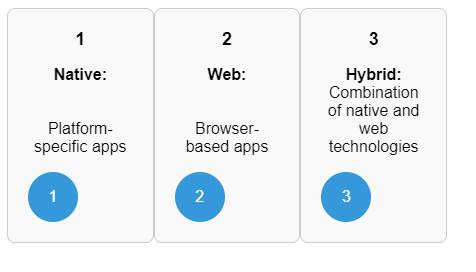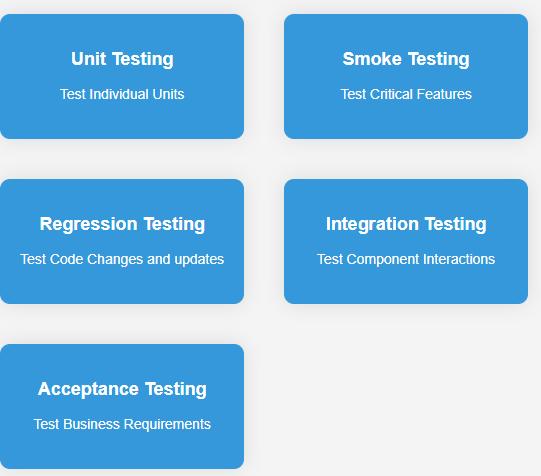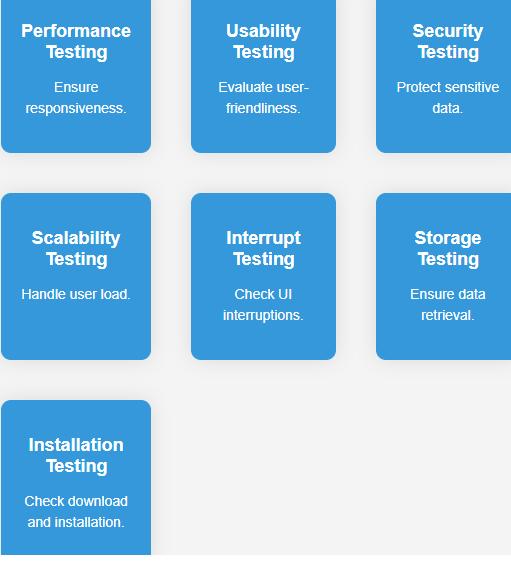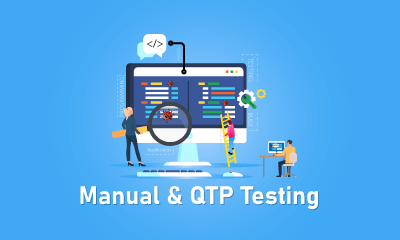- Home
- Blog
- Mobile Application Testing
- Mobile Application Testing Tutorial

Whenever you plan to build an application, it is important to focus on the technical aspect of the product as well as the end-user experience. Hence, Testing the various features of the application is also important. It allows us to check whether the application stands against the market expectations and the customer’s expectations.In this article, we will learn about Mobile Application Testing and its various components such as Functional Testing, Performance Testing, Load Testing, etc. So let us start without any delay.
Table of Contents
- What is Mobile App Testing?
- Prerequisites
- Types of Mobile Applications
- Mobile App Vs Web App Testing
- Different Methods for Mobile Testing
- Types of Mobile App Testing
- Mobile App Testing Tools
- What is Mobile Test Automation?
- How to Create a Mobile Testing Plan?
- Example Test Plan for Mobile Application
- Frequently Asked Questions
What is Mobile App Testing?
Mobile App Testing allows us to test the functionality, performance, and usability of mobile applications. It is a crucial part of the software development lifecyle that enables the users to ensure the best quality of their applications. In simple words, it is a technique through which the system experts test the features of the mobile application. They also ensure that the app can be used across the various platforms for which it has been developed.
Apart from this, we can get the right inputs from the end-users in the form of feedback and reviews. Mobile Testing also validates the functional and non-functional requirements precisely. Thus, the new updates or releases of the application can be planned accordingly. So it becomes important to learn the Mobile App Testing. But before that let us see what are the prerequisites for this tutorial.
| If you want to enrich your career and become a professional in Mobile App Testing, then enroll in "Mobile Application Testing Training". This course will help you to achieve excellence in this domain. |
Prerequisites
This is a beginner-friendly tutorial to learn about the Mobile App Testing. However, to become an expert Mobile App Tester, you must have strong knowledge of the fundamentals such as Types of testing like White Box and Black Box Testing. Also, you should have a basic knowledge of the Mobile App Frameworks and web technologies like Client-Server Architecture, JavaScript, etc. Hence, the fundamental knowledge will help you to easily test and validate your application.
Types of Mobile Applications
Before testing your application, it is important to know what type of application it is and what is its purpose. The types of Mobile Applications are discussed as stated below.

Types of Mobile Applications
- Native Application: Native Applications are those that have a specific platform dependency. In other words, developers create these apps using platform-specific languages. For example, iOS apps are created using Swift, and Android Apps are created using Kotlin. You can access features of native apps through specific platforms only. And, if you want to develop these apps for other platforms, you have to create a separate development strategy.
- Web Application: Users access web apps through mobile browsers. These are developed using the web technologies such as HTML, CSS, React.Js, JavaScript, etc. These can be accessed by different platforms. However, they support features that are device-specific and can be accessed through a particular device only.
- Hybrid Application: Some applications have to be accessed by a diverse user base. In that case, Hybrid Apps are used that support both the features of Native and Web Apps. The software experts develop Hybrid apps using web technologies but in a native shell so that we can use them from different devices. They are much more challenging to develop as we have to test the app’s performance on multiple devices.
Mobile App Vs Web App Testing
Let us get quick insights into how the Mobile App differs from the Web App Testing. The following Table highlights the difference between the Mobile App and Web App Testing.
| Criteria | Mobile App Testing | Web App Testing |
|
Platform Dependency |
It tests the app based on specific mobile platforms like iOS and Android |
It just validates the Cross-platform compatibility |
| User Interface | It gives importance to device-specific UI/UX testing | Here, we have to test the app across various browsers and screen sizes |
|
Access to Hardware |
This testing tests the access to device features like camera, location, etc. |
It asks for limited access to hardware. It relies more on browser-based features |
|
Installation |
It checks the Installation from app stores or direct download |
It tests accessibility through web browsers and thus, no installation is required. |
|
Offline Functionality |
There is a Consideration for functionality in offline mode |
It validates the internet connection and session. |
|
Updates and Releases |
The updates are managed through app stores |
The app gets the ant updates without requiring app store approvals |
|
Performance |
App Device performance impact is given more importance. |
It is primarily dependent on browser performance |
Different Techniques for Mobile Testing

Different Techniques under the Testing
Emulator-based Testing
Emulators act like real devices that test the behavior of the application from the user’s side. It involves the use of emulators to simulate the behavior of the real device. They mimic the hardware and software configurations and test the applications under various conditions. For example, if the mobile application is a social-media application, the emulators will check how the app behaves while creating posts, commenting on posts, liking posts, etc.
Also, the emulators will try to copy the target devices, including screen size, resolution, operating system, and hardware features to validate the functionality. Some common user Emulators include Android Virtual Devices. We can also integrate them with the automation frameworks so that manual tasks are reduced.
Simulator-based Testing
Simulator-based Testing of the Mobile App is similar to emulator-based testing. The only difference is that the Simulator is used specifically for iOS devices. Hence, if you have built an iOS application, you do need to buy an iPhone or iPad to test the application. The simulator allows you to do this without any physical iOS device.
The simulators belong to Apple's Xcode development environment that provides virtual iOS devices. Developers use Simulators to test and debug the application during the development phase. They help us to test the application using various configurations and environment setups.
Real-device-based App Testing
Here, we have to test the application using physical devices. Thus, we can get an accurate information on how the app performs in the real-world scenarios. We can get authentic data about the end-user experience using this technique. And, it allows us to get precise information about the app’s performance on different screen sizes, resolutions, and operating system versions.
The developers and QA Testers use various devices and combinations to see the app’s features including performance, security, usability user-friendliness, etc. This method can accurately capture the bugs or issues that the simulators or emulators may miss during the testing. Now, let us move on to the classification of the testing into the Functional and Non-Nunctional testing.

Types of Mobile App Testing
Functional Testing
Functional Testing is solely responsible for testing the app’s functionality and core features. In other words, we can say that all the features and capabilities that are expected from the stakeholders and market requirements are tested through Functional Testing. Functional Testing ensures that the application delivers the expected outcomes. It includes several testing techniques which are shown below:

Types of Functional Testing
- Unit Testing: This type of testing involves testing individual units or components of the application in isolation. It allows the testers to ensure the correctness of the individual components. Thus, they perform Unit Testing during the development phase to identify and fix defects early.
- Smoke Testing (Sanity Testing): This testing is used when we have to perform some critical features of the application. Or, we can say that when we want to check whether the application is stable for more advanced testing or not. It detects the potential issues in the system which are generally termed as ‘smoke’ in the system.
- Regression Testing: Suppose you make some changes to the codebase. In such cases, you have to make sure that the behavior of the application is not deviating. Regression testing helps us to ensure that when we make some changes in the codebase. Hence, we can easily identify issues in the new code base.
- Integration Testing: Once we develop the entire application, we have to check whether all the components are working properly or not. Thus, this testing evaluates the interactions between different units or components. So, we can detect issues arising from the integration of individual parts.
- Acceptance Testing: It ensures that the application satisfies business requirements and is ready for release. In this testing type, user acceptance testing (UAT) alpha testing, and beta testing are used.
Non-Functional Testing
Some features of the applications are not specified by the stakeholders or clients. They are implicit in the application. Simply, these features are automatically included in the application. It tests the non-functional features of applications such as performance, usability, security, and scalability. Its main goal is to make sure that the application is compliant with standards beyond the functional requirement. It includes the following types of testing:

Non-functional Testing Types
- Performance Testing: You can examine the responsiveness and stability of the application using this testing. It includes the load, stress, and volume testing to know performance under varying conditions.
- Usability Testing: It allows us to evaluate whether users can use the app easily or not. It focuses on evaluating navigation, design, and the ability of users to accomplish user tasks in an effective manner. In this way, we can enhance the overall user experience.
- Security Testing: It often happens that our application suffers from data breaches and other vulnerabilities. So Security Testing helps us to protect sensitive data and that the application is safe from potential security threats.
- Scalability Testing: When the user base increases by a large amount, the application should be able to bear the load. Scalability Testing helps us to handle the increasing load and the demand.
- Interrupt Testing: Interruptions such as push notifications, alarms, incoming calls, and SMS, often create an impact on the user performance. To solve this problem, Interrupt Testing is used to check and fix any user interface issues or interrupts in the application.
- Storage Testing: Some apps access the device storage for some of its features. Storage Testing tests these features so that the application can easily retrieve the data without any issues.
- Installation Testing: The end-users should be able to download and install the application from the app store. Hence, Installation Testing is used to check whether the application or the updated release can be easily downloaded and installed.
In the next section, we will learn about the various testing tools so that we can easily know what tool will be perfect for our application testing.
Mobile App Testing Tools
In this section, we will learn about various tools and frameworks that are popular in the testing of our applications. Generally, frameworks are classified into Android, iOS, and Cross Platform. It is important to know about various frameworks under this category so that we can select the right one for our use case.
Android App Testing Tools
Espresso: You can use this tool if you want to integrate with the Android Studio. It allows fast and easy writing of the applications through its user-friendly interface. It basically performs the UI Testing of the elements such as user flows and asynchronous operations. Selendroid: It is open source and supports both the Android App and iOS app testing. It is capable of testing the app across multiple devices and interacting with the native apps. Apart from this, we can write test suites in programming languages like C#, Python, and Java.
Robotium: It is specific to Android Application Testing which is done using Java. It provides an API for writing the test cases, which is user-friendly. Hence, it simplifies the process of mobile app testing.
MonkeyRunner: It is an Automation Tool that can automate the UI Testing of the mobile application. We can easily integrate this with Eclipse, Android Studio, and Maven. In addition to this, it supports cross-platform testing so that we can test our application for various environments and configurations.
iOS Testing Tools
XCUITest: XCUITest is the native UI Testing tool. The Testers use it for performance testing and functional testing of the iOS App applications. It allows us to write the test suites in Swift and Objective-C in the easy-to-use API interface.
XCTest: We can use this to perform the Unit and Integration Testing of the macOS and iOS applications. It provides various advanced features like test discovery, test parallelization, and test reporting.
OCMock: It specifically writes the test case for iOS and macOS applications using the Objective-C language. It uses the method of Mock and Stub in which Mock mimics the real device and Stub means the predefined response for some methods at the user end. Hence, we can easily know what kind of user experience will be provided.
Detox: You can use this for testing the Android and iOS applications. It also supports the cross-platform compatibility. Its key feature is that we can integrate with Jest, a JavaScript app testing tool, and Mocha, a popular testing tool.
Cross-Platform Testing Tools
Appium: It is an open-source automation tool for testing mobile applications on both Android and iOS platforms. Its key feature is that you can write test suites in multiple languages like Java, Python, Ruby, and JavaScript, making it accessible to a broad developer audience.
Calabash: Calabash is an open-source framework that we can use for behavior-driven development (BDD) testing for mobile applications. It simply means that the application is developed by focussing its behavior from the user’s perspective. Also, It supports both Android and iOS platforms, providing a platform-agnostic approach to testing.
So, there are lots of frameworks, libraries, and tools for mobile app testing. It all depends on business-specific and product-specific requirements. These can help us to select the right testing tool for our application.
What is Mobile Test Automation?
Automation simply means reducing human efforts. Thus, Mobile Test Automation focuses on using testing tools and frameworks to perform tests on mobile applications without manual operations. This process allows us to perform the parallel test execution on multiple devices. This reduces the overall testing time and helps us to use a feedback loop in the development process.
Hence Mobile Test Automation streamlines the testing of mobile apps by automating repetitive and time-consuming testing tasks. We can say that:
- Mobile Test Automation is the process in which the Testers create and execute the scripts that mimic user interactions with mobile applications. For example, these scripts can perform actions such as tapping, swiping, entering text, and navigating through the app feature.
- It is mainly used in Regression Testing in which we have to ensure that the new changes or updates do not create a negative impact on the existing functionality of the applications.
Now, let us learn how to create a Testing Plan to implement for the mobile application.
How to Create a Test Plan for a Mobile App?
Creating the Test Plan for the Mobile Application requires a series of steps. You can easily follow these steps to implement the Testing of Mobile App. The entire process of the testing plan is stated below.
- Define Test Objectives: First, define a clear objective and goals of testing. The objectives should be such that you can easily know why you want to perform the testing or what features you want to validate.
- Identify Test Scenarios: Now, find the various scenarios and use cases that the mobile application is expected to handle. This includes functional, non-functional, and user experience scenarios. Also, You have to define various parameters such as entry point, and exit point for various test cases.
- Select Testing Tools: First refer to the product documentation and closely observe what is the application's technology stack, platform, and testing requirements. For example, if you prefer to test the UI of the application, you can select the MonkeyRunner.
- Create Test Cases: Select the language in which the Testing Team is comfortable and there is no effect on the business process. Then, develop detailed test cases that cover both positive and negative scenarios. You must ensure to specify inputs, expected outputs, and the conditions under which the tests will be executed.
- Device and Platform Coverage: It is now time to select the devices, operating system versions, and screen resolutions to be included in the test coverage. For this, check what kind of device coves most of the market share. Then, prioritize the test cases for these devices first to ensure customers of major end-users.
- Execution and Reporting: Now, decide a testing schedule, and execute automated tests on selected devices. After this, generate detailed test reports for monitoring the test execution. You can also use this data can be also used for enhancing future testing scenarios.
Example Test Plan for Mobile Application
Let us consider an example of for understanding Mobile App testing in a much better way. Imagine that you have created a Social Media Application with the name ‘FriendHub.’ Thus, testing this application should validate basic features like messaging, connecting with friends, and sharing content.
Hence, the Testing Plan would include the following test scenarios for which we have to write a test case:
- User registration and login
- Exploring posts and shared content
- Connecting with friends
- Sending and receiving messages
- Creating and managing groups
- Planning and participating in events
Now consider the third test suite which is connecting with friends. In this test scenario, we have to write the test cases for functionalities such as:
- Search for friends.
- Send friend requests.
- Accept or decline friend requests.
- View friend profiles.
We have to write test cases for each functionality in the test plan and then execute it. After the Execution, we have to generate the test reports which are shared with the stakeholders and Developer team to identify the areas of improvement.
Frequently Asked Questions
1. How does Mobile Test Automation address support device fragmentation?
Mobile Test Automation fixes device fragmentation by enabling parallel test execution on multiple devices. This allows us to test our app across multiple specifications, screen sizes, and operating systems. Hence, the becomes ready-to-use for multiple devices.
2. What is the significance of performance testing in mobile app testing?
Performance testing tests the applications under varying conditions like different network speeds and device capabilities. It helps identify and resolve performance-related issues before release. Hence, we can ensure a great user experience.
3. What is Cross Browser Testing in Mobile App Testing?
Cross-browser testing validates the performance of our application across various mobile browsers. It includes testing the app under browser environments to ensure that different browser configurations do not affect the app’s performance.
4. Can we integrate Mobile Test Automation with the Continuous Integration/Continuous Deployment (CI/CD) method?
You can easily integrate the testing with CI/CD pipelines so that automated tests are executed automatically during the development and deployment processes. In this way, the development team can get quick feedback and maintain the quality of the app throughout the lifecycle.
Explore Mobile Application Testing Sample Resumes! Download & Edit, Get Noticed by Top Employers!
Conclusion
Mobile App Testing is important not only to check the features of the app but also to ensure that it fits the existing market dynamics. Mobile App Testing includes functional testing to test the core features and Non-Functional Testing for the testing security, reliability, response time, etc. It all depends on business requirements, the skills of the QA Testing Team, and the tool that you have selected for testing your Mobile App.
With the above information, you can easily ensure that all these factors align with each other so that you can launch your Mobile Application to capture the market share.
 On-Job Support Service
On-Job Support Service
Online Work Support for your on-job roles.

Our work-support plans provide precise options as per your project tasks. Whether you are a newbie or an experienced professional seeking assistance in completing project tasks, we are here with the following plans to meet your custom needs:
- Pay Per Hour
- Pay Per Week
- Monthly
| Name | Dates | |
|---|---|---|
| Mobile Application Testing Training | Jan 20 to Feb 04 | View Details |
| Mobile Application Testing Training | Jan 24 to Feb 08 | View Details |
| Mobile Application Testing Training | Jan 27 to Feb 11 | View Details |
| Mobile Application Testing Training | Jan 31 to Feb 15 | View Details |

Madhuri is a Senior Content Creator at MindMajix. She has written about a range of different topics on various technologies, which include, Splunk, Tensorflow, Selenium, and CEH. She spends most of her time researching on technology, and startups. Connect with her via LinkedIn and Twitter .















